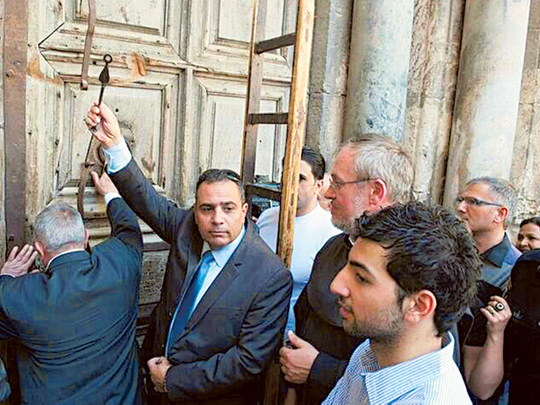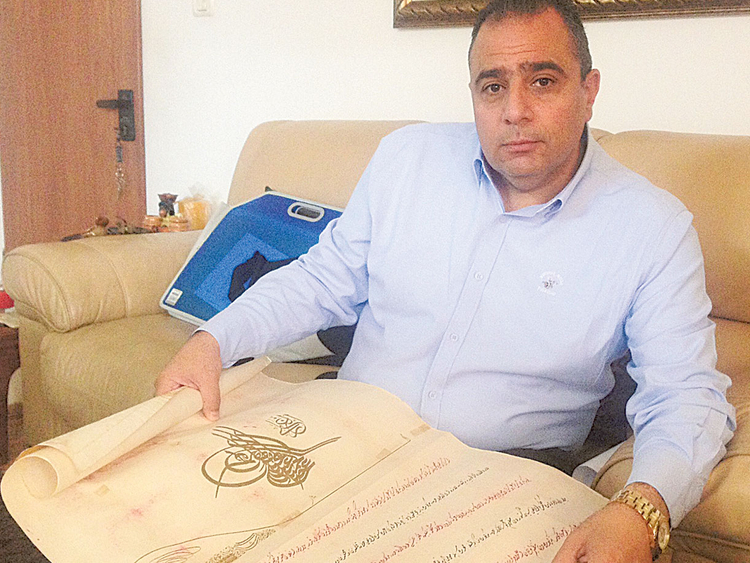
To Palestinians, keys are symbolic of dispossession and loss, of the suffering of those who were driven out of their homeland in 1948. And for generations that followed they have come to signify a hope that they will — someday — return to the land of their ancestors.
In Occupied Jerusalem there’s one key that plays a very special role at Christendom’s holiest site, the Church of the Holy Sepulchre, where it is believed Jesus was crucified and from where he was resurrected. However, little is known about a Muslim family that, as the designated custodian of the church, has been safeguarding this particular key since 1187.
The present custodian, Adeeb Jawad Joudeh Al Hussaini, proudly shows me the cast-iron key. “My family came from Makkah more than a thousand years ago. We trace our roots to the Prophet Mohammad [PBUH] as well as to his cousin Ali Ibn Abu Taleb. During the period of the Crusades in Jerusalem’s history, the Crusaders controlled the church, but when Salahuddin liberated Jerusalem he handed the key to the Shaikh of the Al Haram Al Sharif on which stands the Al Aqsa Mosque and the Dome of the Rock. The Sultan then decreed that the key has to move from father to son, and today I am the custodian of the key,” he says.
“I first touched the key at the age of 8, when my father sent me to celebrate Easter, and at 10, I had the privilege of placing the stamp on the tomb inside the church. I have two jobs — the custodian of the key and of the Holy Tomb seal holder.”
He tells me about the second job. “During Easter, the Patriarch gets the holy light from inside the tomb. We go with Armenian, Coptic, Syrian and Greek Orthodox priests inside the tomb to make sure that there are no candles or lights present. Then the Greek Patriarch comes with the ‘holy wax’, closes the door and places the ‘holy wax’ on the door itself, and my job is to place the stamp on the ‘holy wax’. Once this is done, it means that Christians may begin celebrating Easter. After this, I go to Patriarch Theopolis’s home in the Old City to inform him that all is OK. Then I accompany him back to the church.”
Al Hussaini began doing this job 25 years ago. Now, at 53, he is still very passionate about it. He wakes up at 3am every day and drives from his apartment in the east Occupied Jerusalem suburb of Beit Hanina to the Old City, parks his car in the Armenian Quarter to be in time for the 4am opening of the door to the church.
The daily ritual is like clockwork — Al Hussaini hands the key to a member of the Nusseibeh family who then knocks at the gate to call the priests who spend the night inside. A wooden ladder is passed through a porthole from inside the church to open the two locks — the first is a metre high and the second is three and half metres higher, but the single key opens both of them.
The door is closed at 8.30pm daily.
A notion that has gained currency is that Salahuddin handed the key to this family because various Christian denominations were fighting among themselves. Al Hussaini says that’s not true. “Salahuddin gave the key to our family to protect the church from any sultan after him who might think of destroying it. After Caliph Omar, some sultans destroyed churches. This affected Caliph Omar. He did not want the same to happen in the holy city of Jerusalem. Therefore, to protect the church, Caliph Omar gave the key to the Al Hussaini family who were the Shaikhs of Al Aqsa Mosque, who were highly respected by the Muslims of Jerusalem. So no sultan could even think of destroying the church.”
Al Hussaini believes that it is an honourable thing for him and his family to protect the church, and they have not only earned the respect of the various Christian denominations but also of Muslims. “My father was a student in the school of the Patriarch and he became very close to him,” he says.
Al Hussaini then proudly unveils Royal Decrees from the Ottoman period. In his possession are 165 Royal Decrees, or farman, from 28 sultans of Jerusalem, decreeing his family the custody of the church as well as the tombs of the prophets Moosa, Lot and Younus. He points out that the stamps of the sultans are in pure gold.
The first Royal Decree was issued by Sultan Salim Al Awal in 1517 and the last by Sultan Mohammad Rashid Al Khamis in 1908.
When the British occupied Jerusalem, the Shaikh of Al Aqsa Mosque was summoned by General Allenby. Al Hussaini still has the letter dated July 11, 1921. “Allenby asked the Shaikh why a Muslim family was in possession of the key of the church. My grandfather told him about the history and the protection given to the church, especially the reason why Salahuddin gave my family the key. Allenby told him that he won’t be more generous than Salahuddin and gave him full responsibility to continue.”
As for financial compensation, Al Hussaini says, “It was written in the Royal Decrees that a payment of three and a half gold coins monthly was to be given for the service. After 1967 when Israel took over, that stopped and a payment of 25 Israeli shekels was offered, which we have not received since.”
Talking about the present situation, Al Hussaini says, “The occupation of Jerusalem with regular closures by Israelis creates many difficulties for Christian pilgrims during Easter and Christmas seasons.”
Nevertheless, Al Hussaini continues this age-old tradition without any monetary payment, but with a sense of pride that his family has been bestowed with this noble duty.
In essence, Caliph Omar Ibn Al Khatib decreed that the Church of the Holy Sepulchre should be a source of peaceful coexistence between Muslims and Christians and it was simply reinforced by Salahuddin who encouraged people of both religions to live together in the Holy City. And the Al Hussaini family has played a key role in sustaining this, and continues to do so.
Rafique Gangat, author of “Ye Shall Bowl on Grass”, is based in Occupied Jerusalem.













